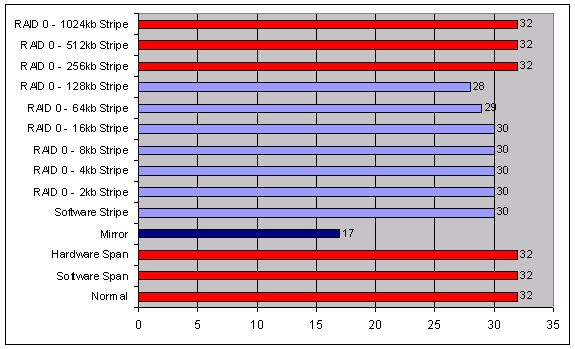Sisoft Sandra Disk Benchmark
Sequential Read

Ah... This is where the advantage of RAID 0 is really apparent. With striping, sequential reading performance was doubled for those with a small stripe size (<64 KB). This means that the files used in the benchmark were quite evenly spread out between the two drives, effectively allowing the data to be read in parallel.
For bigger stripe sizes, the stripe blocks might actually be bigger than the files themselves, allowing more than a file to fit into a single stripe block. This means that when reading such files, the RAID 0 array can only achieve a transfer rate similar to that of a single hard disk drive. This shows in the performance hit in tests with stripe sizes of 128 KB and above.
We actually expected the RAID 1 (mirrored) array to perform much better. This is because during reads, it is possible for RAID 1 to achieve a sort of pseudo-parallel data transfer where each hard disk drive could potentially serve different file requests. Even if the software isn't that intelligent, they could also show a marked decrease in seek time as the two hard disk drives can simultaneously seek different areas of the platters.
However, RAID 1 performed only as well as a normal non-RAID single hard disk drive setup. We can only conclude that the Promise FastTrak100 ATA RAID card does not implement such optimizations.
Buffered Write

When it comes to write performance, you can quickly see that the RAID 1 (Mirrored) array has only about half the throughput as the other configurations. Again, this is because of its need to write the same data to two different hard disk drives.
It's surprising to note that while RAID 0 with large stripe sizes (>256 KB) did not perform well during reads, they now top the chart, albeit not by much. It's also interesting that RAID 0 with the 128 KB stripe size seemed to be the worst performing RAID 0 setup.
Support Tech ARP!
If you like our work, you can help support out work by visiting our sponsors, participate in the Tech ARP Forums, or even donate to our fund. Any help you can render is greatly appreciated!
Page |
Topics |
|
|
1 |
|||
2 |
|||
3 |
• RAID 0 |
||
4 |
• RAID 1 |
||
5 |
|||
6 |
• RAID 5 |
||
7 |
|||
8 |
|||
9 |
|||
10 |
|||
11 |
|||
12 |
|||
13 |
|||
14 |
|||
15 |
|||
16 |
|||
17 |
|||
18 |
|||
19 |
|||
20 |
|||
21 |
|||
22 |
<<< Sisoft Sandra Disk Benchmark - Overall Score & Buffered Read : Previous Page | Next Page : Sisoft Sandra Disk Benchmark - Sequential Write & Random Write >>>







 Add to Reddit
Add to Reddit
